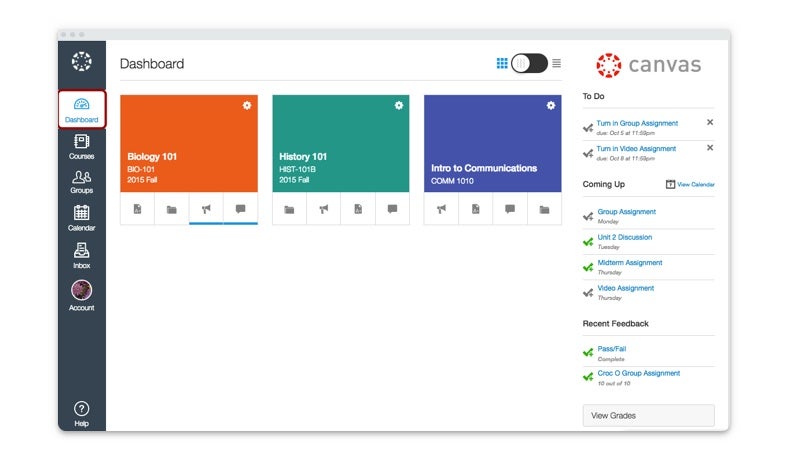Teachers, want more resources for online teaching? Parents, need some insight into what online programs your kid’s school may be using for their remote education? We have the answers.
Ready or not, 2020 brought a whole new set of students and teachers to the online learning community. While education has slowly been integrating with online tech for years, never before have we seen such a swift adaptation to a new way of teaching and learning.
We went straight to the source and spoke with teachers ranging from elementary to college-level to find out the best online resources and tech tools for teaching online. Here’s what they said.
Get right to the recommendations
Teachers’ top picks
Honorable mentions
Extra credit
Thank you to our contributors:
Suzanne Halaburda, M.A., Senior Lecturer, UNC Charlotte
Susanne Kostaras, middle school special education teacher
Jennifer Mitchell, English teacher, grades 9-12
Kristen Mulrain, elementary school teacher
Kim-Ling Sun, M.A., Jr./Sr. Dual Credit English, Klein Cain High School
Melissa A. Venable, Ph.D., online instructor at Saint Leo University
Best in class: The top online teaching tools
These six online learning tools were mentioned most often among the educators we spoke with, and it’s easy to see why. The following online learning resources allow for customization, ease of use and collaboration between teachers and students alike.
The first three online tools — Canvas, Brightspace and Schoology — are Learning Management Systems (LMS). LMS is a type of software used to organize, track and record multiple online learning programs. It lets students and teachers access all learning materials in one place, with one login.
Canvas
Canvas was mentioned by more than one teacher as the LMS they relied on most. Canvas is an online platform that lets schools and teachers customize students’ online learning environment. Teachers can interact with their students through Canvas to schedule assignments, supply additional learning activities, post grades and more.
Jennifer Mitchell, English teacher for grades 9-12, said, “We have been using Canvas as our learning management platform for the past few years, so our students had the advantage of being familiar with using Canvas.”
What can you do with Canvas? According to online university instructor Melissa Venable, platforms such as Canvas “provide a central place for students to log in and access all course information (e.g., syllabus, assignment instructions, grades, updates) and materials (including reading assignments, activities, multimedia) and participate in the course through discussion forums, live meetings and recorded presentations.”
Plus, through the Canvas system, students and teachers can “link to other online learning programs such as IXL, Albert.io, AP Classroom, ReadTheory, ReadWorks, Commonlit and more,” added Mitchell. “Many companies have been providing free usage of their online programs during this time, and teachers have been able to explore many different options in search of the most effective tools for online instruction.”
Canvas dashboard

Brightspace
Brightspace, or D2L, is another cloud-based online learning platform, similar to Canvas. Brightspace is made of three primary components: a Learning Environment for teachers to design courses, a Learning Repository for organizing resources and an ePortfolio where students can interact with each other.
Another perk for platforms such as Brightspace and Canvas is their integrated apps for today’s busy students. “LMS mobile apps make these classes more portable than ever,” said Venable.
Schoology
Most schools opt to use one universal LMS system for all e-learning activities. However, some teachers had the option to use more than one LMS.
Kim-Ling Sun, teacher of Dual Credit English at Klein Cain high school in conjunction with Lonestar college, said, “Both institutions I work for have available LMS systems to interact with students. Lonestar College utilizes D2L and my public high school uses Schoology. I opted to utilize Schoology with my students as it was most familiar to them and proved to be a wise decision once COVID had us do at-home learning.”
No matter which LMS they opted to use, the teachers we spoke with all agreed these software programs were essential. Sun said, “It provides a place for discussion forums and easier tracking of the submission of student work (due to time stamps) and grades. On the educator side, it allows me to quickly address any questions students may have and provide supplemental information to multiple classes simultaneously.”
Google Docs
Several teachers mentioned the Google suite of programs as a crucial part of online learning.
“When teaching online, I’ve found Google Docs to be helpful because groups of students can easily collaborate, and I can join in their work at any time to help and provide group feedback,” said Suzanne Halaburda, Senior Lecturer at UNC Charlotte.
“Google Docs and Google Slides can also be shared and students are able to collaborate on projects and assignments,” said middle school special education teacher Susanne Kostaras.
It’s odd to think of email as “old-fashioned” but in our fast-paced tech environment, that is typically how it is viewed. However, more than one teacher we spoke with named the humble e-mail as one of their top resources for connecting with their students on a more individualized level.
“I’ve found that it is important to reach out to students individually, to check in every once in a while to remind them of something they’re missing, to ask if there is anything I can help them with, or to ask what has been most helpful for them in class recently,” said Halaburda. “Taking the time to send individual emails a few times each semester helps me keep track of how students are doing, of what’s working and what’s not.”
Venable echoed this same sentiment, saying, “Email remains a solid communication tool for online instructors and students. This is usually the fastest way for students to reach me.”
Zoom
Multiple educators mentioned Zoom as a crucial instrument in their online teaching toolbelt. “Zoom and other video platforms were incredibly generous and immediately stepped up to strengthen their networks for a huge influx of new school users, all for free,” said Kostaras.
Despite some initial rumblings over Zoom security concerns, Kostaras added, ”I could not have survived the past couple of months without Zoom. They tightened up security quickly with password requirements, so I felt very safe using it.”
“Right now I hold office hours one evening each week using Zoom,” said Venable. “These sessions can also be recorded so that students with conflicting schedules can watch when they can.”
Sun said, “Zoom became necessary in the age of COVID to hold Socratic Seminars. It was also beneficial for me to hold face to face conferences during COVID. I loved that I was still able to make personal connections to my students while we were physically apart.”
The personal exchanges on Zoom were essential for Kostaras as well. She said, “I met with my students in very small groups, ‘face to face,’ and we were able to laugh and learn together.”
And despite their somewhat short attention spans, elementary school students were able to interact successfully with teacher Kristen Mulrain using Zoom for weekly class meetings.
Honorable mention: Teaching tools you don’t want to miss out on
Teachers Pay Teachers
Named as one of the top 50 Most Innovative Companies in 2019 by Fast Company, website Teachers Pay Teachers lets educators share resources person to person, while earning some extra income too.
“Teachers were sharing ideas and some very creative materials on social media teacher pages as well as the Teachers Pay Teachers website. Some even shared their Bitmoji virtual classrooms, which they made to look like their real classrooms,” said Kostaras.
If you’ve never heard of a Bitmoji virtual classroom, check this one out. Using the cartoon avatars, teachers can recreate the classroom experience with customizable room interiors — and it’s overall just super-cute.

GoFormative
The GoFormative app lets teachers create tasks and quizzes, provide feedback and track data. Plus, students can access the content from any laptop, tablet or smartphone.
Mulrain said she often uses the site to create multiple choice or short answer questions for her students.
Screencastify
Screencastify, a Chrome browser extension, has provided free usage for teachers during this pandemic. It gives educators three different recording options to provide instruction for students.
Using Screencastify, “I have been able to walk my students through the process of annotating documents online, demonstrate how to use other programs, work with peer editing tools in Google documents, conduct research for essays/projects, and so much more,” said Mitchell.
Remind
Mobile messaging platform Remind helps students, teachers and parents stay informed about deadlines, assignments, schedule changes and more, without disclosing personal contact information.
“Since this tech pushes notifications through the app and can be set up to send text messaging, we can have free communication while not tied to a laptop,” said Sun. “In the age of COVID, it was instrumental in my students being able to get very individualized help when they had time in their schedule to tackle their classwork (as many had to take care of siblings and work during the day). I often have students send me a quick question while they are at practice, doing homework, or even backstage at rehearsal.”
Document camera
The next two teaching tools aren’t websites but hardware technology that can come in handy for teaching remote.
A document camera looks similar to a desk lamp, but you can display materials to an online audience by placing materials under the camera lens. Think overhead projector for the 21st century.
“One thing I found extremely helpful once I got myself situated in my new kitchen ‘classroom’ was a document camera. I was able to share my screen with my students and manipulate materials like number blocks, coins, letter cards, etc. I could place worksheets under the camera and using Zoom’s annotation tools, my students and I were able to complete them together,” explained Kostaras.
Document camera

Chromebooks
Now that learning is 100% remote, limited digital access, or the homework gap, is a more pressing concern for many students. Luckily, many school districts have distributed Chromebooks to all at-home students.
“The most useful tool in online learning has been our county’s 1:1 ratio of all middle and high school students having chromebooks,” said Mitchell. “Since the students use the Chromebooks daily in class, the students were familiar with using the computers and online applications teachers assign in the physical classroom. We were so much better prepared for the move to online learning because of the Chromebooks.”
Extra credit: Even more online resources for teachers
The educators we spoke with also mentioned the following websites as supplemental learning for their students. Some of these can be accessed through learning management systems like Canvas or Brightspace, or you can visit these sites individually.
Check out these 18 other online resources for teachers
- Albert.io – core subjects and test prep, grades 5-12
- AP Classroom – practice materials for AP courses and exams
- Boom Cards – interactive, self-checking flash cards, K-12
- Clever – digital classroom platform, K-12
- CommonLit – free reading passages, 3rd-12th grade
- Discovery Education – digital curriculum resources, K-12
- IXL – create a personalized curriculum, K-12
- Khan Academy – free online courses for nearly every subject and level.
- Lalilo – phonics, word recognition and comprehension, K-2nd grade
- MobyMax – find and fix learning gaps, K-8th grade
- Mystery Science – science lessons, elementary
- ReadTheory – reading comprehension for K-12, ESL and adult students
- ReadWorks – free reading comprehension tools, K-12
- Rocket Math – math games and worksheets, K-4th
- TED-Ed – short videos for educators and students
- TED Talks – free video on a variety of topics
- Wordwall – make quizzes, word games and more
- YouTube EDU – limits access to educational content only and disables comments
The educators all seemed positive about the future of online learning and were happy to share information on their most-used resources. The longer that remote learning goes on, the more teachers, technology and students will evolve and adapt to this way of instruction.
Looking for other tech resources for the student in your life? Check back at the Resource Center or follow our experts on Facebook and Twitter.
Written by:
Lisa IscrupeWriter, Broadband & Data Content
Lisa uses years of experience in sales and customer service for internet-TV providers to inform her writing on broadband. Her work has been referenced by CNN and other national sources.
In Lisa’s Words: Ever…
Read more
Edited by:
Robin LaytonEditor, Broadband Content
-
Featured
![Does remote learning feel more like detention? These online resources make studying fun]() Does remote learning feel more like detention? These online resources make studying fun Lisa Iscrupe — 4 min read
Does remote learning feel more like detention? These online resources make studying fun Lisa Iscrupe — 4 min read -
Featured
![Student and teacher internet deals & tech discounts]() Student and teacher internet deals & tech discounts Camryn Smith — 5 min read
Student and teacher internet deals & tech discounts Camryn Smith — 5 min read -
Featured
![Guide for schools and students: Resources for free internet, computers and tech]() Guide for schools and students: Resources for free internet, computers and tech Joe Supan — 9 min read
Guide for schools and students: Resources for free internet, computers and tech Joe Supan — 9 min read
Latest
-
Wednesday, April 24, 2024
Why do you need an Optical Terminal Network?Taylor Gadsden — 2 min read
-
Tuesday, April 23, 2024
Worried about losing your TV signal? This is how to keep your satellite dish cleanDavid Anders — 6 min read
-
Tuesday, April 23, 2024
How to change your Wi-Fi network passwordCamryn Smith — 2 min read





